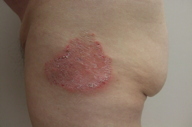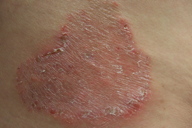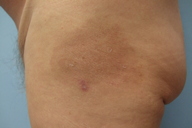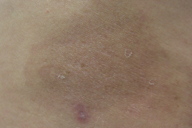Radiation port dermatophytosis: Tinea corporis occurring at the site of irradiated skin
Published Web Location
https://doi.org/10.5070/D370d74631Main Content
Radiation port dermatophytosis: Tinea corporis occurring at the site of irradiated skin
Kathleen M Casamiquela BA1, Philip R Cohen MD2,3,4
Dermatology Online Journal 18 (1): 5
1. Medical School, The University of Texas-Houston Medical School, Houston, Texas2. The University of Houston Health Center, University of Houston, Houston, Texas
3. The Department of Dermatology, The University of Texas M.D. Anderson Cancer Center, Houston, Texas
4. The Department of Dermatology, University of Texas-Houston Medical School, Houston, Texas
Abstract
Radiation port dermatophytosis is the occurrence of tinea corporis within the area of radiation therapy delivery. A 68-year-old man, while receiving proton beam radiation for adenocarcinoma of the prostate, developed a dermatophyte infection in the area of the radiotherapy port. Including this patient, 4 patients with radiation port dermatophytosis have been reported in the world literature. The epidemiology, clinical manifestations, histopathology, diagnosis, pathogenesis, and treatment of this condition are discussed. The diagnosis of radiation port dermatophytosis may be missed because it is misinterpreted as radiation-induced dermatitis. Thus, it is possible that radiation port dermatophytosis may be more prevalent in patients receiving radiation therapy.
Introduction
Radiation port dermatophytosis is the development of tinea corporis at the site of irradiated skin. A man with prostate adenocarcinoma developed radiation port dermatophytosis during his treatment with radiation therapy. The clinical manifestations, pathogenesis, and treatment of radiation port dermatophytosis in this patient and the previously reported individuals with this condition are reviewed.
Case report
A 68-year-old white man presented for evaluation of a progressively enlarging pruritic red lesion on his left thigh. His past medical history is significant for chronic lymphocytic leukemia in remission, a previously excised meningioma, and prostate adenocarcinoma. His prostate cancer was diagnosed in February 2010 and had initially been treated with androgen deprivation treatment using Lupron 22.5 mg intramuscularly monthly for 12 months.
The patient then received proton beam radiation treatment for his prostate cancer. Simulation was performed 2 weeks prior to treatment. The bandage on his left thigh, which covered the field markings detached; he subsequently developed an allergic contact dermatitis to the adhesive of the new bandage prior to receiving radiation therapy.
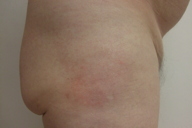 | 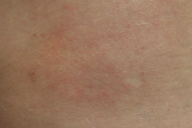 |
| Figure 1a | Figure 1b |
|---|---|
| Figure 1 (a and b). Distant (a) and closer (b) of the right thigh showing radiation therapy-associated erythema confined to the area treated with proton beam radiation. | |
The patient received 39 sessions of proton beam therapy over the course of 8 weeks with 2 cobalt gray equivalents per fraction using 225 MeV protons for a total of 78 cobalt gray equivalents. The patient was examined 3 days after completing radiation therapy. The right thigh demonstrates an annular erythematous smooth dermal plaque without any epidermal changes that measured 7 cm x 7 cm (Figure 1); these findings were consistent with proton beam radiation therapy-associated skin erythema. The left thigh shows an erythematous raised plaque with a scaling border that measured 8.5 cm x 7 cm (Figure 2).
A potassium hydroxide preparation, which was only performed from the scaling border on the left thigh, was negative; hyphae were not observed. However, because the diagnosis of radiation port dermatophytosis was still being entertained, a biopsy was only performed from the left thigh lesion’s edge. The periodic acid-Schiff stain demonstrated septate fungal organisms in the stratum corneum confirming the suspected diagnosis of tinea corporis in the left thigh lesion.
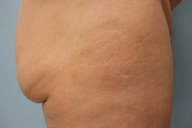 |  |
| Figure 3a | Figure 3b |
|---|---|
| Figure 3 (a and b). Distant (a) and closer (b) views of the right thigh four weeks after the completion of radiation therapy shows resolution of radiation-associated erythema. | |
The left thigh, which had developed allergic contact dermatitis and subsequently dermatophytosis infection, was treated with ketoconazole 2 percent cream twice daily for 4 weeks. Betamethasone diproprionate 0.05 percent cream, for symptomatic relief of the acute inflammation from the contact dermatitis, was also applied twice daily for 3 days. There was complete resolution of both the radiotherapy-associated erythema on the right thigh (Figure 3) and the radiation port dermatophytosis on the left thigh (Figure 4) after 1 month of treatment.
Discussion
Dermatophytosis confined to the irradiated skin was first described by Maor in 1988 in a 32-year-old man with neurofibromatosis type 1-associated neurofibrosarcoma of the right axillae. He developed tinea corporis on his right neck and posterior shoulder after receiving cobalt-60 radiation therapy. The dermatophyte infection developed 3 weeks after the onset of radiation therapy and resolved after 2 weeks of treatment with clotrimazole 1 percent topical solution [1].
The term, radiation port dermatophytosis, was introduced by Rosen et al in a subsequent paper that republished Maor’s patient and also described a 50-year-old man with squamous cell carcinoma of the larynx who received cobalt-60 radiation therapy. One week after the onset of treatment, he developed tinea corporis on his face and neck in the area treated with radiotherapy. The dermatophyte infection resolved after being treated with clotrimazole 1 percent cream for 2 weeks [2].
Subsequently, a third patient with radiation port dermatophytosis was reported in 1992. He was a 33-year-old man who had undifferentiated carcinoma in the nasopharynx and had received 60-cobalt radiation therapy. He developed tinea corporis on his neck approximately 2 weeks after onset of radiotherapy. His radiation port tinea corporis resolved spontaneously within 4 weeks concurrent with the skin desquamation associated with his acute radiation dermatitis [3].
The characteristics of individuals with radiation port dermatophytosis are summarized in Table 1 [1, 2, 3]. All the patients were men between the ages of 32-68 years old. Three of the men were treated with supervoltage gamma rays and our patient was treated with proton beam radiation. Radiation therapy associated radiation port dermatophytosis developed within 3 weeks after initiation of radiation therapy in all of the men.
The location of radiation port dermatophytosis is dependent on the site of radiation treatment. The neck was involved in 3 of the 4 patients. Our patient had tinea corporis on his left thigh. Three of the patients had inflammatory cutaneous tinea corporis lesions, which presented as erythematous plaques. However, 1 patient’s radiation port dermatophytosis had a non-inflammatory presentation.
Our patient developed only 1 plaque of dermatophytosis after radiation therapy was begun. However, the other 3 men developed multiple plaques of tinea. Half of the patients had scaling surrounding the periphery of the plaques. Our patient developed scaling throughout his plaque. The 50-year-old man developed verrucous shaped plaques. Finally, 2 of the patients developed papules in addition to plaques on the irradiated skin.
The suspected diagnosis of radiation port dermatophytosis was confirmed in 3 patients by observing a positive potassium hydroxide preparation, which showed hyphae; fungal culture also identified the organism in 2 of these individuals. Our patient had a negative potassium hydroxide preparation. However, radiation port dermatophytosis was still suspected and a lesional punch biopsy (stained with periodic acid-Schiff stain) subsequently confirmed the diagnosis by showing septate hyphae in the stratum corneum.
Acute radiation dermatitis, contact dermatitis, and tinea corporis are some of the clinical conditions that are included in the differential diagnosis of a new skin lesion appearing in the radiation port of a patient who is being treated with radiation therapy. Three of the patients who received supervoltage gamma radiation had concurrent acute radiation dermatitis, which mimicked their diagnosis of tinea corporis. Our patient, who had received proton beam radiation, developed treatment-associated erythema on his dermatophytosis-free right thigh. Skin erythema is a common radiation attributed reaction in patients receiving proton beam radiation therapy [4].
Our patient had also developed allergic contact dermatitis related to an adhesive bandage used to cover his simulation markings prior to receiving radiation therapy. Therefore, the lesion on the left thigh not only showed allergic contact dermatitis but also a concurrent dermatophyte infection in the radiation port. In contrast, the lesion on the right thigh was consistent with radiation-induced erythema alone.
Radiation port dermatophytosis occurred in the setting of radiation therapy of a solid tumor. However, based on the paucity of reported patients, there does not appear to be a specific tumor that is more commonly associated with the development of tinea corporis in the radiation port. Perhaps, an increased awareness of this condition may prompt the detection and description of additional observations; possibly certain cancers may be more frequently associated with the development of tinea corporis in the radiation field.
Radiation port dermatophytosis has only been reported in 4 men. In these individuals, radiation port dermatophytosis and radiation-induced dermatitis occurred at the same time. Therefore, tinea corporis occurring in irradiated skin may be more common than the literature suggests but may be misinterpreted as radiation-induced dermatitis--particularly in patients receiving supervoltage gamma rays [3]. Radiation-induced dermatitis develops during radiation therapy and persists after completion of treatment until it usually resolves spontaneously. In contrast, radiation port dermatophytosis begins during radiotherapy and either resolves when the superficial skin desquamates as a result of the radiation-induced dermatitis or when it is treated with a topical antifungal agent [3]. Finally, similar to our patient, a concurrent contact dermatitis may be clinically present in the site of radiation port dermatophytosis.
The pathogenesis of radiation port dermatophytosis remains to be established. Nevertheless, it may be caused – at least partially – by the radiation-created “immunocompromised district” in the skin that is being exposed to the radiation. The concept of an “immunocompromised district” was introduced by Ruocco et al in 2009. The investigators postulated that once a skin site is injured – either by chronic lymphedema, herpetic infections, vaccinations, or physical injuries (such as ionizing or ultraviolet radiation, thermal burns, and trauma) – it subsequently may become susceptible to the development of conditions such as infections (fungal and viral), malignancy, and autoimmune diseases [5].
Histologic changes occur secondary to treatment with radiation. The dermal tissue undergoes an inflammatory response during radiation therapy that includes swelling and proliferation of capillary endothelial cells. This results in the accumulation of protein rich fluid within the interstitial space, creating lymphedema [6]. A sequela of lymphedema is inadequate drainage of lymph fluid, which creates an obstruction within the lymphatic system and can result in the interference of communication between peripheral neuromediators that bind to receptors on the surface of immune cells. Superficial dermatophyte infections may subsequently occur because normal communication processes on the surface of cells are needed to initiate a proper immune response to prevent fungal infections [5].
Changes occurring at a cellular level may also predispose individuals receiving radiotherapy to develop radiation port dermatophytosis. Radiation is capable of destroying radiosensitive precursor T-lymphocytes and Langerhans cells. Also, because the epidermis regenerates rapidly, keratinocytes are also acutely affected by radiation therapy. Hence, radiation may alter the function of Langerhans cells (which are involved in cell-mediated immunity by presenting fungal antigens to T lymphocytes), or keratinocytes, or both and thereby interfere with the tissue immune response against fungal infections [2].
We speculate that the pathogenesis of radiation port dermatophytosis may be multifactorial. Radiation increases the risk of developing an infection because the treatment affects rapidly proliferating keratinocytes and Langerhans cells and eventually results in the creation of an immunocompromised district of skin. In addition, microscopic and macroscopic lymphedema (presenting as extravasations of fluid in the dermis and swelling of the radiation port skin, respectively) may also inhibit the appropriate immune response to a superficial fungal infection.
Tinea corporis confined to the area previously treated with radiotherapy promptly resolves with topical antifungal treatment. Topical corticosteroids were also concurrently used in our patient as an adjunctive therapy to suppress the associated inflammation during the initial stages of his treatment [7, 8]. All of the patients received between 2 to 4 weeks of treatment [8].
The diagnosis of radiation port dermatophytosis is not a contraindication to continuing radiotherapy and all patients reported continued to receive treatment for their associated malignancy. Two patients began topical antifungal cream to treat their superficial fungal infection while concurrently receiving radiotherapy, whereas two patients began antifungal therapy after completion of their radiation treatment. In patients with acute radiation-induced dermatitis and tinea corporis, it is possible that their tinea corporis partially cleared with the dermatitis-associated superficial desquamation of the skin.
Conclusion
Radiation port dermatophytosis is the development of tinea corporis at the site of the irradiated skin. Radiation port dermatophytosis can mimic acute radiation dermatitis and can occur concurrently with contact dermatitis. The diagnosis can be confirmed by observing hyphae during the microscopic examination of a 10 percent potassium hydroxide preparation of a lesional skin scraping. Alternatively, the diagnosis can be established by demonstrating fungal hyphae in the stratum corneum of a lesional skin biopsy or by growing the organism on a fungal culture taken from the lesion. The development of radiation port dermatophytosis is not a contraindication to continuing radiotherapy. Radiation port dermatophytosis can be successfully treated with topical antifungal therapy. However, when radiation port dermatophytosis and radiation-induced dermatitis are concurrent conditions, the radiation port dermatophytosis may resolve spontaneously with desquamation of the epidermis, thereby eliminating the fungal infection.
References
1. Maor MH: Dermatophytosis confined to irradiated skin: a case report [letter]. Int J Radiat Oncol Biol Phys 1988;14:825-826. [PubMed]2. Rosen T, Dupuy J, Maor M, Altman A: Radiation port dermatophytosis. J Am Acad Dermatol 1988;19:1053-1056. [PubMed]
3. Cohen PR, Maor MH: Tinea corporis confined to irradiated skin: radiation port dermatophytosis. Cancer 1992;70:1634-1637. [PubMed]
4. Rieken S, Habermehl D, Nikoghosyan A, Jensen A, Haberer T, Jakel O, Munter MW, Welzel T, Debus J, Combs SE: Assessment of early toxicity and response in patients treated with proton and carbon ion therapy at the Heidelberg ion therapy center using the raster scanning technique. Int J Radiat Oncol Biol Phys 2001;21:793-801. [PubMed]
5. Ruocco V, Brunetti G, Puca RV, Ruocco E: The immunocompromised district: a unifying concept for lymphoedematous, herpes-infected and otherwise damaged sites. J Eur Acad Dermatol Venereol 2009;23:1364-1373. [PubMed]
6. FitzGerald TJ, Jodoin MB, Tillman G, Aronowitz J, Pieters R, Balducci S, Meyer J, Cicchetti MG, Kadish S, McCauley S, Sawicka J, Urie M, Lo YC, Mayo C, Ulin K, Ding L, Britton M, Huang J, Arous E: Radiation therapy toxicity to the skin. Dermatol Clin 2008;26:161-172. [PubMed]
7. Gupta AK, Cooper EA: Update in antifungal therapy of dermatophytosis. Mycopathologica 2008;166:353-367. [PubMed]
8. Weinstein A, Berman B: Topical treatment of common superficial tinea infections. Am Fam Physician 2002;65:2095-2102. [PubMed]
© 2012 Dermatology Online Journal


